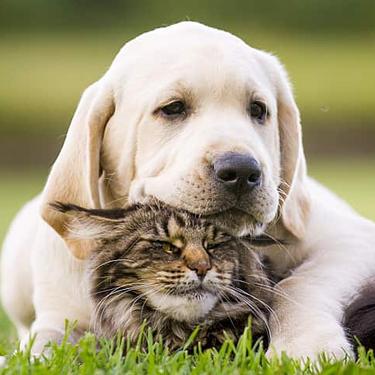

If you're a new pet parent, you may wonder, "Do cats have periods?" or "Why is my cat bleeding?"
Female cats do, in fact, go through a monthly cycle, but their "periods" are quite different from human menstruation. Read on to find out what your cat in heat is feeling and what you can do to help.
Mammals and Menstruation
Female humans and their closest mammalian relatives have menstrual cycles during which the uterine lining sheds outside the body once every 28 to 38 days (there are always variations, of course). Other animals in this small group include the elephant shrew, bats and the spiny mouse.
Other female mammals of reproductive age have a period-like cycle, points out BBC Discover Wildlife, but they "reabsorb the old womb-lining rather than bleed it out." This reproductive process, called estrus but more commonly referred to as being in "heat," is a monthly cycle a female cat undergoes when she isn't spayed.
Cats are polyestrous breeders, explains Animal Planet, which means they go into heat multiple times a year. If a cat doesn't mate, the heat cycle will repeat until she is spayed or becomes pregnant. Additionally, kitties that have all of their reproductive organs (which are necessary for going into heat in the first place) need a minimum of twelve hours of daylight for a normal cycle. But that doesn't mean an indoor cat is safe— cats in a safe environment with artificial light have constant hormonal activity instead of for just half the year, notes Animal Planet. During the heaviest portion of her heat cycle your cat is at the mercy of her hormones, which are kicking into high gear.
Why Is My Cat Bleeding?
"When do cats have periods?" is an important question to consider, because knowing your kitty's cycle will help you to identify why she is bleeding. Like humans, cats begin having an estrus cycle at the start of puberty, around the age of four to six months, and the cycle can last anywhere from seven to ten days. Unlike humans, who are fertile throughout the year, the prime time for cats to enter the estrus cycle is early spring to late fall.
In addition to your kitty's howling and yelping, it's at this time of the cycle that you may notice some light bleeding, which typically isn't worrisome. Most likely, you'll notice spots of blood on the floor or in her bedding. If you are familiar with your cat's cycle and notice something out of the ordinary, contact your veterinarian right away in case there are other health concerns.
Cats are known for their oddball antics, but their weirdness will be amped up during their cycle. Along with making strange and unusual vocalizations, a cat in heat will exhibit unique behaviors, such as rolling on the floor, demanding more attention, rubbing against you or the furniture, spraying urine, or even trying to sneak outside, notes Petful.
Keeping Your Cat Healthy
The heat cycle can be difficult for cats, and the benefits of spaying your pet are numerous. For instance, cats are susceptible to diseases, such as ovarian, uterine and mammary cancer, but the chances of developing them are greatly reduced if your cat is spayed.
According to the College of Veterinary Medicine at Cornell University, your cat should be spayed before she goes into heat for the first time. The spaying procedure, performed at your veterinarian's office, consists of the removal of your cat's reproductive organs, thereby eliminating her estrus cycle (she will no longer go into heat) and her possibility of becoming pregnant. Because cats can become pregnant during their very first reproductive cycle, it's important to have her spayed in order to prevent feline overpopulation, emphasizes The American Society for the Prevention of Cruelty to Animals®. Kittens are cute, but there just aren't enough loving homes for all of them.
When you first adopt your cat, be sure to ask whether or not your cat is spayed. If you're unsure, consult with your veterinarian during your fur baby's wellness appointment. This is also a good time to ask your veterinarian for more information about your cat's cycle and how to stop it from happening. While dealing with your cat during her estrus cycle may seem like a new challenge to understand, being educated and continuing to care for your cat the best you can is a great first step.


















